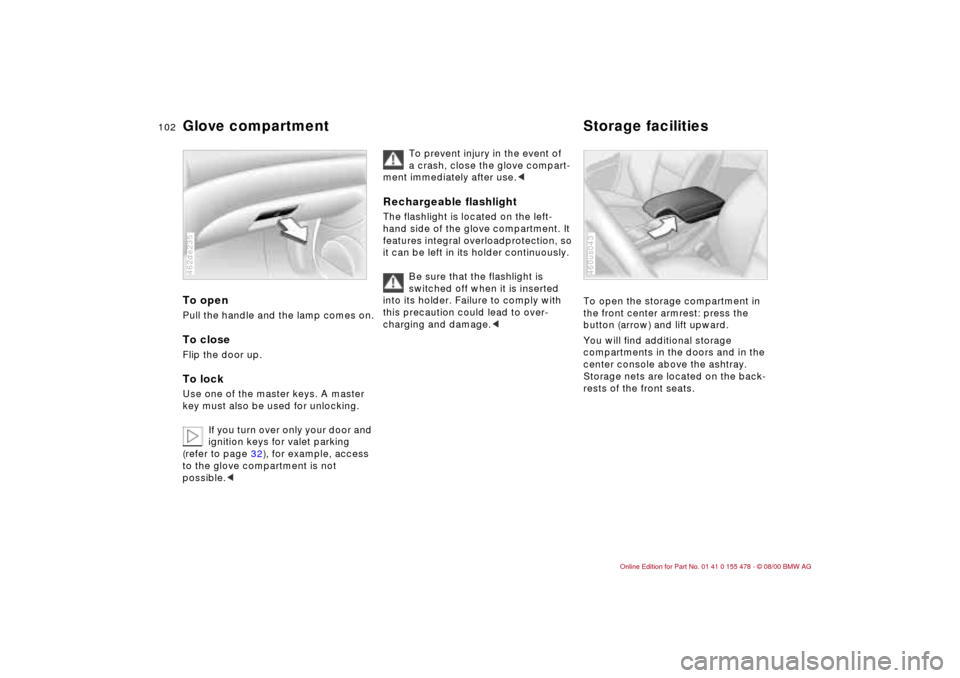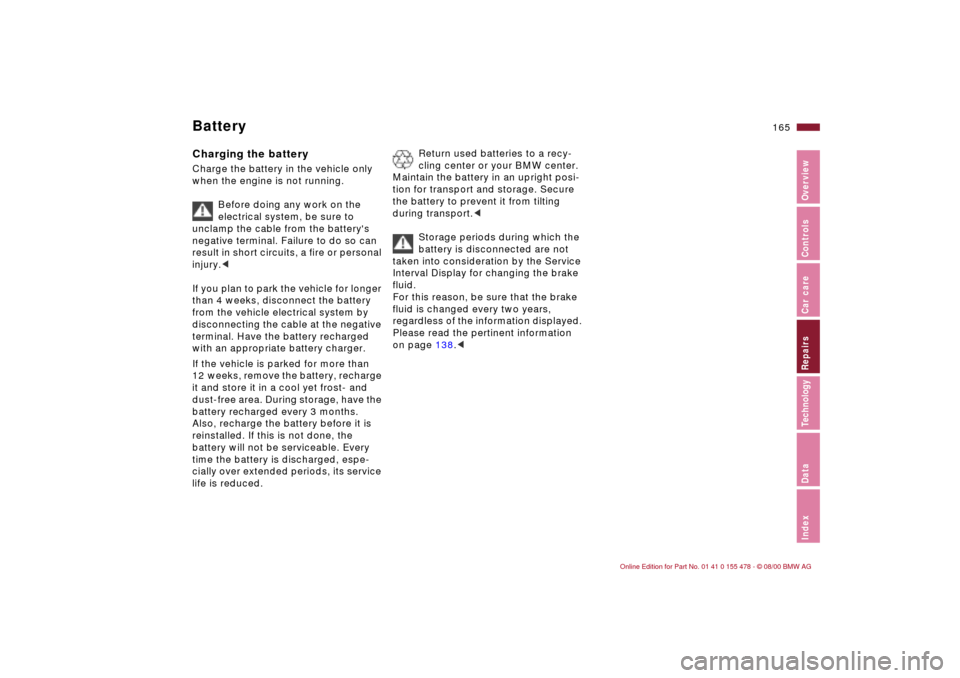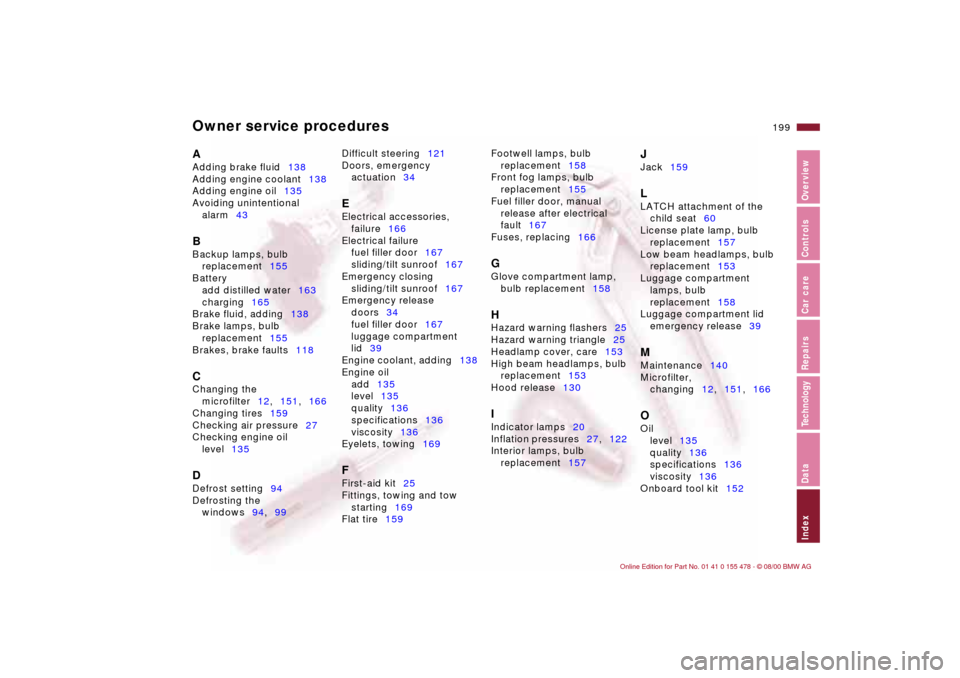2001 BMW 330Ci COUPE charging
[x] Cancel search: chargingPage 20 of 203

20n
Indicator and warning lamps
Technology that monitors itself
Many of the systems of your BMW
monitor themselves automatically, both
during engine starts and while you are
driving. Indicator and warning lamps
that are identified by "
l
" are tested for
proper functioning whenever the igni-
tion key is turned. They each light up
once for different periods of time.
If a fault should occur in one of these
systems, the corresponding lamp does
not go out after the engine is started, or
it lights up while the vehicle is moving.
You will see how to react to this below.
Red: stop immediately
Battery charge
l
The battery is no longer being
charged. There is a malfunction
of the alternator V-belt or in the
charging circuit of the alternator. Please
contact the nearest BMW center.
If the V-belt is defective, do not
continue driving, otherwise, the
engine could be damaged due to over-
heating. If the V-belt is defective,
increased steering effort is also
required.
<
Engine oil pressure
l
Stop the vehicle immediately
and switch off the engine.
Check the engine oil and top off as
required. If the oil level is correct,
please contact the nearest BMW
center.
Do not continue driving. If you do
so, the engine could be damaged
because of inadequate lubrication.
<
Tire Pressure Control (RDC) l
In addition, an acoustic signal is
sounded: a tire failure has
occurred. Reduce vehicle speed imme-
diately to stop the vehicle. Avoid hard
brake applications. Do not oversteer.
For additional information, refer to
page 85.
Brake hydraulic system l
If the lamp comes on when the
parking brake is not engaged:
check the brake fluid level. Before
driving further, be sure to read the
notes on pages 118 and 138.
Brake warning lamp for Cana-
dian models.
Page 64 of 203

64n
Starting the engine Switching off the engine Do not press the accelerator pedal
while starting the engine.
Do not actuate the starter for too
short a time, but do not actuate it
for more than approx. 20 seconds.
Release the ignition key immediately
when the engine starts.
Do not allow the engine to warm up by
leaving it running while the vehicle
remains stationary. Instead, begin
driving immediately at a moderate
engine speed.<
If the engine does not start on the first
attempt (if it is very cold or hot, for
instance):
>Press the accelerator pedal halfway
down while engaging the starter.
Cold starts at very low temperatures,
starting at about +57 (Ð156) and
at high altitudes above 3,300 ft
(1,000 meters):
>On the first start attempt, engage the
starter for a longer period (approx.
10 seconds).
>Press the accelerator pedal halfway
down while engaging the starter.
Engine idle speed is controlled by the
engine computer system. Increased
speeds at start-up are normal and
should decrease as the engine warms
up. If engine speed does not decrease,
service is required.
To prevent the battery from
discharging, always deactivate
electrical devices that are not in
use. Switch the ignition off when the
vehicle is not being driven.Turn the ignition key to position 1 or 0.
Do not remove the ignition key
while the vehicle is still moving.
If you did so, the steering lock would
engage when the steering wheel is
turned.
Whenever you leave the vehicle, always
remove the ignition key and lock the
steering wheel.
Vehicles with manual transmission:
Always apply the parking brake when
parking on slopes and inclined
surfaces, since placing the shift lever in
1st gear or reverse may not provide
adequate resistance to rolling.
Vehicles with automatic transmission:
Place the selector lever in "Park."<
Page 102 of 203

102n
Glove compartment Storage facilities To openPull the handle and the lamp comes on.To closeFlip the door up.To lockUse one of the master keys. A master
key must also be used for unlocking.
If you turn over only your door and
ignition keys for valet parking
(refer to page 32), for example, access
to the glove compartment is not
possible.<462de235
To prevent injury in the event of
a crash, close the glove compart-
ment immediately after use.<
Rechargeable flashlightThe flashlight is located on the left-
hand side of the glove compartment. It
features integral overloadprotection, so
it can be left in its holder continuously.
Be sure that the flashlight is
switched off when it is inserted
into its holder. Failure to comply with
this precaution could lead to over-
charging and damage.<
To
open the storage compartment in
the front center armrest: press the
button (arrow) and lift upward.
You will find additional storage
compartments in the doors and in the
center console above the ashtray.
Storage nets are located on the back-
rests of the front seats.460us043
Page 165 of 203

165n
IndexDataTechnologyRepairsCar careControlsOverview
BatteryCharging the battery Charge the battery in the vehicle only
when the engine is not running.
Before doing any work on the
electrical system, be sure to
unclamp the cable from the battery's
negative terminal. Failure to do so can
result in short circuits, a fire or personal
injury.<
If you plan to park the vehicle for longer
than 4 weeks, disconnect the battery
from the vehicle electrical system by
disconnecting the cable at the negative
terminal. Have the battery recharged
with an appropriate battery charger.
If the vehicle is parked for more than
12 weeks, remove the battery, recharge
it and store it in a cool yet frost- and
dust-free area. During storage, have the
battery recharged every 3 months.
Also, recharge the battery before it is
reinstalled. If this is not done, the
battery will not be serviceable. Every
time the battery is discharged, espe-
cially over extended periods, its service
life is reduced.
Return used batteries to a recy-
cling center or your BMW center.
Maintain the battery in an upright posi-
tion for transport and storage. Secure
the battery to prevent it from tilting
during transport.<
Storage periods during which the
battery is disconnected are not
taken into consideration by the Service
Interval Display for changing the brake
fluid.
For this reason, be sure that the brake
fluid is changed every two years,
regardless of the information displayed.
Please read the pertinent information
on page 138.<
Page 192 of 203

Everything from A to ZA
ABS (Antilock Brake
System)22,115
ABS, fault116
Accessories6
Activated-charcoal
filter100,166
Adaptive Transmission
Control (ATC)67,174
Adding
engine oil135
washer fluid134,187
Adjusting
backrest48
head restraints48
lumbar support49
steering wheel52
temperature92,98
Air conditioner90
Air distribution92,98
Air nozzles90,96
Air outlets90,96
ventilation90,96
Air pressure122
Air supply92,99
Airbags21,57,146,175
sitting properly58
Alarm system42
Antenna121
Diversity176
Antifreeze137
radiator119 Antilock Brake System
(ABS)22,115
Anti-theft alarm system42
Approved weight and load
capacities186
Approved wheel and tire
specifications127
Aquaplaning113,122
Armrest102
ASC+T (Automatic Stability
Control plus
Traction)22,82,175
Ashtray
front104
rear105
ATC (Adaptive Transmission
Control)67,174
Attach vacuum cleaner105
AUC (Automatic
recirculated-air
control)99
Automatic car washes141
Automatic climate
control96
remove window
condensation99
Automatic cruise control73
Automatic dimming, interior
rearview mirror53
Automatic recirculated-air
control (AUC)99 Automatic Stability Control
plus Traction
(ASC+T)22,82,175
Automatic transmission with
Steptronic21,67
Automatic windshield
washer71
Average consumption79
Average speed80
Avoiding unwanted
alarm43
Axle loads186
B
Backrest, releasing49
Backup lamps66
bulb replacement155
Battery163,188
capacity188
charge current20
charging165
discharged168
removal and
installation164
Battery safety terminal164
Battery terminal164
Belts55
Blower92,99
BMW High Performance
Synthetic Oil136
BMW Maintenance
System140 BMW sports seat49
Bore184
Brake fluid138
Brake hydraulic system20
Brake lamps, bulb
replacement155
Brake pads22
Brake system118
Brakes117
malfunctions118
Break-in procedures112
Bulb replacement152
Bulbs152
C
California Proposition
65 Warning148
Capacities187
Car Memory54
Car radio121
refer also to the separate
Owner's Manual
Car radio
reception121,176
Car vacuum cleaner105
Car wash141
Care
exterior142
interior144
Care of upholstery145
Care of wool velour145
Page 199 of 203

Owner service procedures
199n
IndexDataTechnologyRepairsCar careControlsOverview
A
Adding brake fluid138
Adding engine coolant138
Adding engine oil135
Avoiding unintentional
alarm43 B
Backup lamps, bulb
replacement155
Battery
add distilled water163
charging165
Brake fluid, adding138
Brake lamps, bulb
replacement155
Brakes, brake faults118 C
Changing the
microfilter12,151,166
Changing tires159
Checking air pressure27
Checking engine oil
level135 D
Defrost setting94
Defrosting the
windows94,99 Difficult steering121
Doors, emergency
actuation34
E
Electrical accessories,
failure166
Electrical failure
fuel filler door167
sliding/tilt sunroof167
Emergency closing
sliding/tilt sunroof167
Emergency release
doors34
fuel filler door167
luggage compartment
lid39
Engine coolant, adding138
Engine oil
add135
level135
quality136
specifications136
viscosity136
Eyelets, towing169 F
First-aid kit25
Fittings, towing and tow
starting169
Flat tire159 Footwell lamps, bulb
replacement158
Front fog lamps, bulb
replacement155
Fuel filler door, manual
release after electrical
fault167
Fuses, replacing166
G
Glove compartment lamp,
bulb replacement158 H
Hazard warning flashers25
Hazard warning triangle25
Headlamp cover, care153
High beam headlamps, bulb
replacement153
Hood release130 I
Indicator lamps20
Inflation pressures27,122
Interior lamps, bulb
replacement157
J
Jack159 L
LATCH attachment of the
child seat60
License plate lamp, bulb
replacement157
Low beam headlamps, bulb
replacement153
Luggage compartment
lamps, bulb
replacement158
Luggage compartment lid
emergency release39 M
Maintenance140
Microfilter,
changing12,151,166 O
Oil
level135
quality136
specifications136
viscosity136
Onboard tool kit152